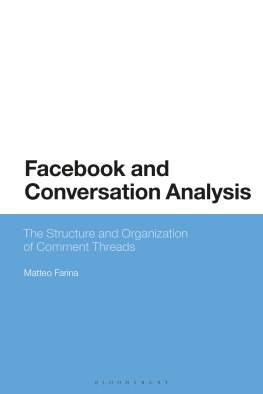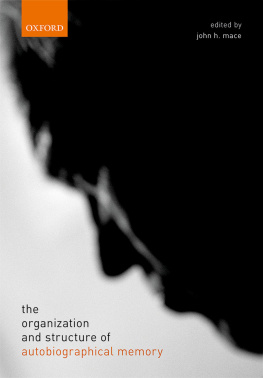Facebook and Conversation Analysis
Also available from Bloomsbury:
A Critical Hypertext Analysis of Social Media , Volker Eisenlauer
Discourse and Identity on Facebook , Mariza Georgalou
Discourse of Twitter and Social Media , Michele Zappavigna
Facebook and Conversation Analysis
The Structure and Organization of Comment Threads
Matteo Farina

Contents
Comment threads on the FB Home. |
The Rispondi (Reply) button. |
Screenshot of an FB comment thread. |
Nowadays a large part of our everyday interactions takes place online. We continuously send and receive notifications, e-mails, WhatsApp messages, tweets, and so on; we also share photos, videos, and hyperlinks using smart phones, computers, tablets, and so on. In addition, almost everyone has a Facebook (FB) account. Two billion people are in fact on FB and 1.3 billion use this social network on a daily basis (Facebook, 2017). This means that a lot of social interactions take place on FB; this book focuses on these interactions. It applies the ideas of Conversation Analysis (CA) to describe the structure of comment threads, which are interactions that occur among FB users on the homepage of this website, the so-called Home. More precisely, based on a corpus of comment threads posted by speakers of Italian, it examines the comments that open these interactions and the contributions that come after them.
Conversational analytic studies have shown that in spoken conversation turns at talk do not casually follow one after the other, but they are organized in a structure (Liddicoat, 2011; Sacks, 1992; Sacks, Schegloff, and Jefferson, 1974; Schegloff, 2007). As Liddicoat (2011) claims, turns at talk are clustered together, ordered in a meaningful way. This organization is called sequence organization . The idea of sequence organization depends on a fundamental principle of spoken conversation, which is that when a speaker utters a sentence he or she performs an action which generates another action, which in turn makes another action relevant, and so on (Liddicoat, 2011; Sacks, 1992; Schegloff, 2007). This means that by analyzing the actions performed by speakers in a conversation, it is possible to understand how an interaction is organized (Liddicoat, 2011; Sacks, 1975, 1992; Schegloff, 2007).
A request is generally followed by an acceptance or a decline, a question by an answer, a greeting by another greeting, and so on. This means that turns at talk are commonly organized in pairs, where the action performed by the first part of the pair makes the action accomplished in the second part of the pair the relevant next. The concept of sequence organization has thus been introduced by Sacks et al. (1974) to describe what normally happens in spoken conversation, which is that turns at talk are organized in sequences because of the actions they perform.
Several studies have pointed out that sequence organization is also identifiable in online contexts, especially in chats and discussion forums (Antaki et al., 2005; Garcia and Jacobs, 1998, 1999; Reed, 2001; Schnfeldt and Golato, 2003; Tudini, 2010, 2013). In other words, people tend to organize online interactions like they develop spoken conversations, for example, by using adjacency pair sequences .
Previous research has also shown that the affordances and constraints of the system in which an interaction occurs impact on the organization, especially if this interaction is computer mediated (Antaki et al., 2005; Garcia and Jacobs, 1998, 1999; Reed, 2001; Schnfeldt and Golato, 2003; Tudini, 2010, 2013). For example, while spoken conversation is an oral form of interaction, many forms of online communication are written. Moreover, while participants in spoken conversations, with the exception of phone conversations and similar exchanges, are normally copresent at the time of an interaction, this is not the case in online interactions, where participants are generally geographically dispersed. Finally, while spoken conversation is synchronous, which means that it occurs in real time, this is not true of many forms of online interactions, where a user may post a contribution at one point in time and another user might respond to it after several hours or even several days. Therefore, previous studies have demonstrated not only that the notion of sequence organization can be applied to online interactions but also that the system in which an interaction occurs may impact on the way this interaction is organized.
Although previous research has paid considerable attention to analyzing the sequence organization of online chats, discussion forums, e-mail exchanges, and blogs, it is interesting to consider whether this organization is also identifiable in FB comment threads. If this is the case, this study will prove that contributions do not randomly occur in FB interactions but that they are orderly and this order depends on the actions performed by FB users in comment threads. This book therefore utilizes the ideas of CA to describe the sequence organization of FB comment threads and it addresses the following research questions:
Are comments within FB comment threads organized in an identifiable structure?
If so, what is the sequence organization of FB comment threads?
In recent years FB has become extremely popular among scholars of different disciplines, and this has resulted in a huge amount of literature. The following section will present a brief overview of the studies that have examined FB, focusing especially on those that have analyzed this social medium from a linguistic perspective.
Previous work on Facebook
Social networks are websites that invite users to create a profile, connect with other users, and communicate with them (Boyd and Ellison, 2007; Golder, Wilkinson, and Huberman, 2007). FB is the most popular social network site of the world (Papacharissi and Mendelson, 2010; Prez-Sabater, 2013). This popularity has attracted the attention of scholars from different disciplines, including communication (Barbulet, 2013; Baym, 2015; Boyd and Ellison, 2007; Dong, 2008; Farman, 2012; Papacharissi, 2010; Stern and Taylor, 2007; Taecharungroj and Nueangjamnong, 2015), anthropology (Lampe, Ellison, and Steinfield, 2006; Miller, 2011), sociology (Castells, 2013; Gennaro and Dutton, 2007; Golder, Wilkinson, and Huberman, 2007; Harper, 2011; Leonardi, 2009; Stutzman, 2006; Tufekci, 2008; Westlake, 2008; Zhao, Grasmuck, and Martin, 2008), education (Bugeja, 2006; Cheung, Chiu, and Lee, 2011; Davies, 2011; Hew, 2011; Hsu et al., 2012; Kitsis, 2008; Sheldon, 2008a, 2008b, 2009), and second language acquisition (Blattner and Fiori, 2009; Godwin-Jones, 2008; Kabilan, Ahmad, and Abidin, 2010; Mills, 2009). The purpose of some of these papers is beyond the scope of this book; what will be presented here is therefore a brief overview of studies which are relevant to the aim of this work, namely those which have proposed a linguistic description of FB.
Some of the linguistic studies on FB have focused on status updates, the contributions that open comment threads, which are the interactions that take place on the FB Home. For example, Bolander and Locher (2010) and Carr, Schrock, and Dauterman (2012) undertook two studies which applied speech act theory to analyze status updates, and they both found that these updates essentially consist of assertive and expressive speech acts. Status updates have also been examined by Lee (2011), Farina (2015), Georgakopoulou (2013b), Georgalou (2015b), Giaxoglou (2015a, 2015b), West (2013), Page (2010b, 2012), and Page, Harper, and Frobenius (2013). These scholars applied discourse and conversation analysis to investigate status updates; they all suggested that these messages consist of narratives, more precisely, stories (Giaxoglou, 2015a, 2015b), small stories (Georgakopoulou, 2007a, 2007b, 2013b, 2014; Georgalou, 2015b; Page, 2010b, 2012; Page, Harper, and Frobenius, 2013; West, 2013), tellings (Farina, 2015), and a form of micro-blogging (Lee, 2011).











